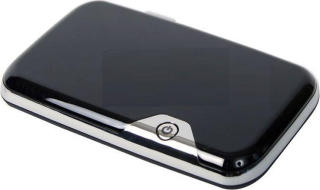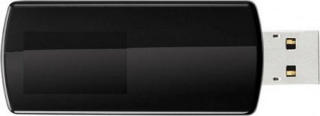Choosing a Cellular Data Connection
To use a cellular data connection with the integrated Windows 8 capabilities, or what Microsoft calls mobile broadband, you must have a Windows PC or device that includes a built‑in SIM port. If you don’t have such a thing, you utilize external methods for connecting to the Internet via a cellular data connection. Some of the more obvious choices include the following:
• Portable wireless router: Many wireless carriers sell tiny wireless routers that access their data networks and then broadcast a Wi‑Fi network that you can use with multiple devices and PCs. From the perspective of Windows 8, connecting to such a device is no different from connecting to any Wi‑Fi wireless network. A typical device, such as the Novatel MiFi, is resold by a number of wireless carriers and shown in Figure 13‑8
• Smartphone or tablet Internet sharing: Smartphones and tablets are generally available with built‑in SIM cards and cellular data connectivity of their own, and some can share that connection over Wi‑Fi with other devices and PCs, much like a wireless router. This process is sometimes called Internet tethering, because sharing a smartphone’s Internet connection in particular can lead to a quick loss of battery life. So it’s advisable to connect, or tether, the phone to your PC via a USB cable to keep it charged. Windows 8 interacts with these networks as it does with any Wi‑Fi type wireless network.
Figure 13‑8: A portable wireless router can connect multiple PCs and devices to a cellular data network.

• USB dongle: Many wireless carriers also provide small USB devices that plug into a PC (or Windows‑based device with a USB port), providing cellular connectivity directly to that PC. These devices typically come with their own software stack, so that they work with all modern versions of Windows, and if you use such a device, it’s likely that you’ll need to install this software before you can get online. In such cases, usage will vary, since the provided utilities will vary from device to device. A typical cellular data dongle is shown in Figure 13‑9.
Figure 13‑9: You can add cellular data connectivity to any PC using an external USB dongle.

If you’ve purchased a modern Windows 8 PC or device, especially a portable computer such as a laptop, Ultrabook, tablet, or hybrid PC, chances are good that it came with at least a SIM module, which would allow you to later add a SIM card and associated data plan from your wireless carrier of choice and use that connectivity to access the Internet on the go.
The placement and accessibility of this SIM port will vary from machine to machine. They’re generally well‑hidden, hard to access, and only need to be fiddled with once (if at all): when you install the SIM card the first time.
Availability and cost of cellular data will also vary by wireless carrier, so you’ll want to consider your needs–that is, whether you’ll typically use the connectivity from the same basic location (home, work, the local coffee shop) or while traveling. That’s because cellular data coverage varies from place to place, and while certain carriers offer great coverage in one area, they may offer terrible coverage elsewhere, if at all.
You’ll also need to consider your data needs, planning, and shopping accordingly. Some wireless carriers offer pay‑as‑you‑go plans, while others require you to sign up for 2 years and pay a standard monthly fee for a set amount of data (with additional payments made for overages). We happen to use AT&T Wireless in the United States at the time of this writing, and this company offers the following pay‑as‑you‑go data plans for Windows‑based PCs and tablets with a built‑in LTE‑based SIM card.
Prepaid plans with an auto‑renew option and anytime termination:
250 MB monthly pass $15
3 GB monthly pass $30
5 GB monthly pass $50
These plans expire when you have used all the data in your plan or your time expires, whichever occurs first. Any “leftover” never carries forward to the next time period, sorry. But AT&T also happens to offer international data add‑ons for world travelers, another option to consider. However, this is just an example; you’ll want to shop around.
Determining how much data you need can be difficult. Fortunately, with a pay‑as‑you‑go plan, you can adjust over time until you settle on the plan that makes the most sense for you.
Дата добавления: 2015-05-13; просмотров: 1250;
